Units 1-9 Overview
Most
teenagers today rely on social media on their smartphones to stay connected. In
Units 1-9, you will read and analyze social media's risks and benefits in
preparation for your argumentative essay. To prepare for this essay, you will
read four anchor texts that each offer a unique reason for how social media is
both positive and negative. You will read:
·
"This is Your Brain on Instagram" explores how social media
affects the mind.
·
"Teens Say Social Media Isn't As Bad for Them As You Might Think"
is a text about the benefits of social media
interactions.
·
"This Muslim-American Teen Turned His Suffering Into A Full-Fledged
Battle Against Stereotypes" is a text about the benefits of social
media interactions.
·
"Why Young Adults Are Taking A More Mindful Approach to Social Media"
to understand the benefits of unplugging from social media.
By the end of Unit 9, you will
write a 5-Paragraph Argumentative Essay with the following prompt:
Is social media more
beneficial or risky for teenage students?
Introduction of an
Argumentative Essay
Unit 1 Overview
This unit
provides an introduction to argumentative writing and aims to develop your
skills in written communication. Through four lessons, you will learn about the
purpose of argumentative writing, the structure of an argumentative essay, and
review the different parts of speech. The first lesson will define
argumentative writing, and the second lesson will break down the essay into its
introduction, body, and conclusion. In the third lesson, you will study a model
essay and analyze its structure and content. Finally, in the fourth lesson, you
will study the different parts of speech and common grammatical errors to avoid.
By the end
of this unit, you will have a strong foundation in argumentative writing and
the necessary skills to begin crafting your own argumentative essays.
Argumentative Writing
A
strong argument can help convince others to change their minds or take
action on issues you care about.
To develop
a strong argument, you must express your opinions clearly and back them up with
Evidence and reasoning.
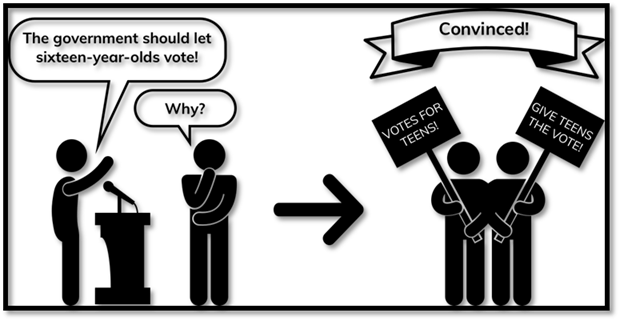
Writers
use argumentative essays to convince readers of their opinions.
An
argumentative essay is more effective if it is well organized.
Parts of Argumentative Essay
|
Argumentative
Essay: Outline 5 Paragraph
Essay |
|
1. Introduction a. Hook b. Bridge (Background Information) c. Thesis 2. Body
Paragraph - Reason 1 a. Topic Sentence - Claim b. Textual Evidence – Explanation c. Textual Evidence – Explanation d. Reasoning 3. Body
Paragraph - Reason 2 a. Topic Sentence -Claim b. Textual Evidence – Explanation c. Textual Evidence – Explanation d. Reasoning 4. Body
Paragraph - Opposing Arguments a. Topic Sentence (Claim) b. Textual Evidence for opposing
arguments reason – Explanation c. Rebuttal d. Textual Evidence for
Rebuttal – Explanation 5. Conclusion a. Restate Claim (Thesis) b. "So What" Statement |
Part 1: Introduction
The first
part of the essay is the introduction.
The length
of an introduction is one paragraph.
Your introduction sets
the tone for your whole essay.
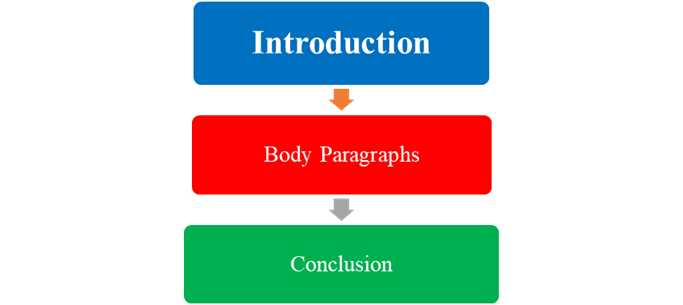
In your
introduction, your job is to grab the reader's attention and state the
debatable opinion or thesis that you are arguing.
Introductions in argumentative essays have three components.
1.
The first component is your hook.
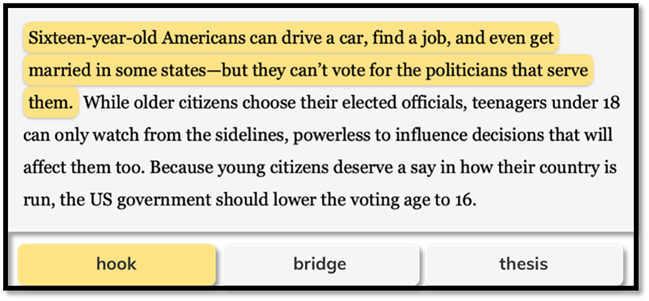
Your hook should
grab readers' attention with an interesting quote, fact, claim, or description.
It will
connect to the thesis statement of your essay.
2.
The second component of your introduction is your bridge.
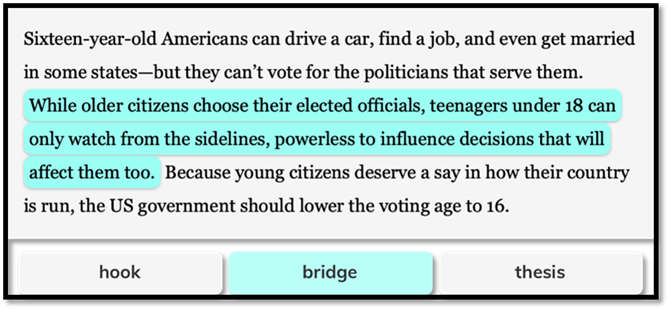
Your bridge creates
a smooth transition between your hook and your thesis statement.
Your bridge
is a good place to provide relevant background
information, but only include enough context to help readers understand
your thesis. If you include less here, your readers might gain interest.
3.
The final component of your introduction is your thesis statement.
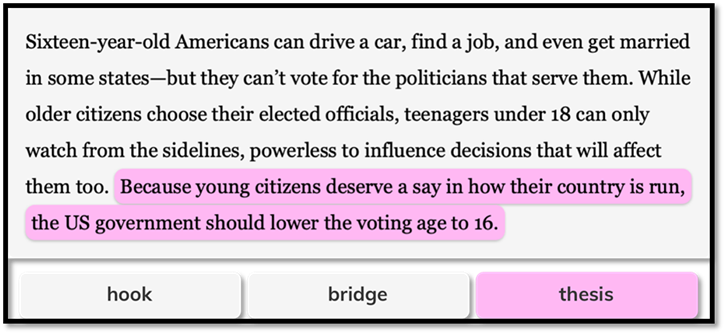
Your thesis is
the opinion you will argue in your essay.
Your
readers will only know what you want them to believe if you have a clear thesis
statement.
Below are
some sentence frames that you can use to write an argumentative thesis
statement:
A debatable thesis
statement makes your essay more interesting because there's room for discussion
and disagreement. If your thesis statement is too broad, readers are unlikely
to feel strongly about it.
Part 2: Body Paragraph
The second part of your essay is the body paragraphs.
The length of the body paragraph is three paragraphs.
· Paragraphs 1 and 2 will be reasons that
support the thesis.
· Paragraph 3 will be your opposing
argument of the thesis.
Your body paragraphs have the most
important job in your argumentative essay.
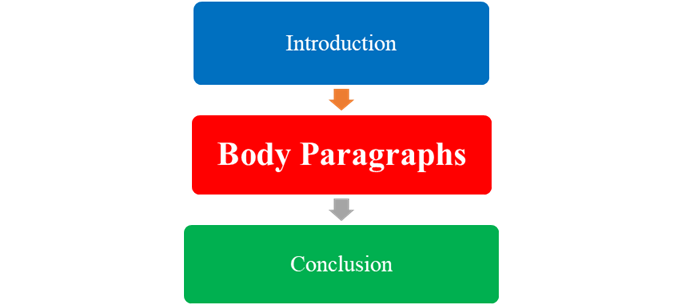
These
paragraphs should convince readers of your thesis
using claims, Evidence, and reasoning.
Body
Paragraphs in argumentative essays have three
components.
1. The first part is your topic sentence.
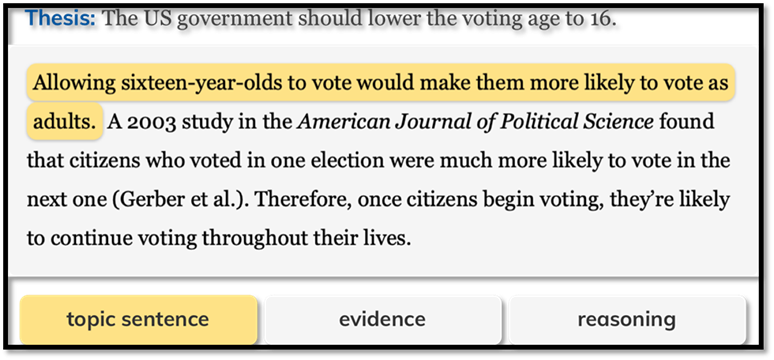
Your topic
sentence should be a claim that supports your thesis.
Claims
are opinions, not facts. If your topic sentence states a fact, you
don't need to convince your readers that it's true!
2. Next, support your claim with Evidence.
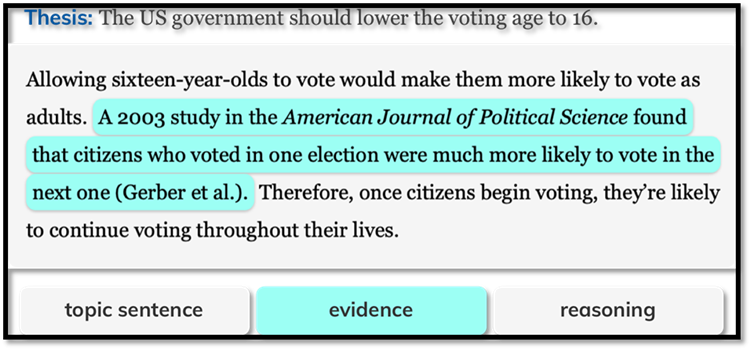
Use Evidence
to convince readers that your claim is true. Strong Evidence must be a fact,
statistic, or quotation from a credible source supporting your topic sentence.
In an
argumentative essay, Evidence supporting a claim must be a fact from a credible
source. Facts include statistics, specific examples, and quotations. Credible
sources include newspapers, online journals or research publications, and
experts.
Below are
some phrases you can use to introduce evidence:
- for
example
- for
instance
- specifically
- in
fact
- according
to
3. Finally, use reasoning to show your readers how your Evidence supports your
claim.
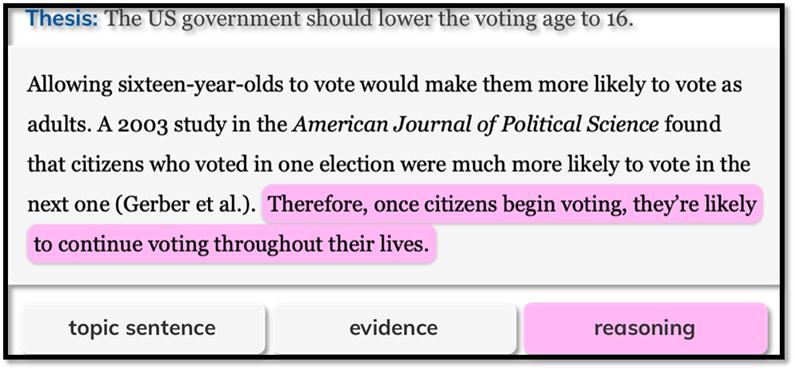
In your
reasoning sentences, draw a conclusion from your Evidence
and explain how that conclusion supports your claim.
While the
connection between your Evidence and claim may be obvious, your readers will be
more convinced if you explain it.
Below is a
complete body paragraph.
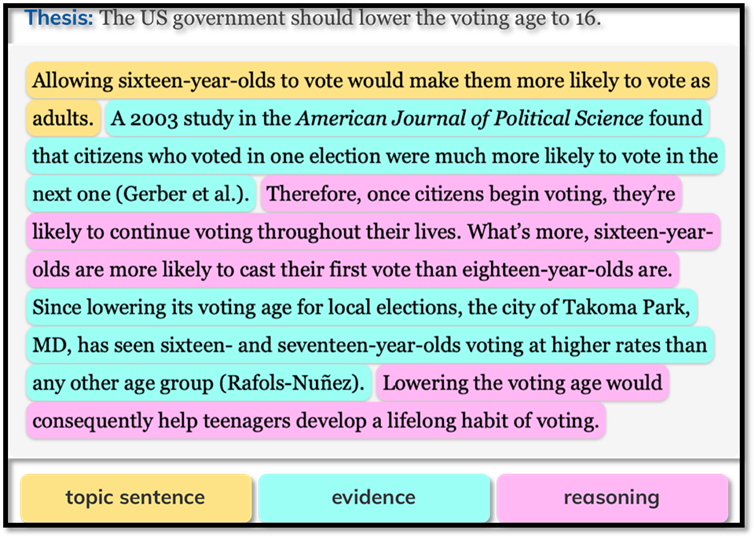
You can put
your Evidence and reasoning in any order that makes sense as long as your
reasoning shows how the Evidence supports your claim.
You must
cite any ideas that you found in other writers' work. Using someone else's
words without a citation is plagiarism, and your readers won't trust you if you take credit for
others' ideas.
To avoid
plagiarism, you must cite
your evidence and
present it in one of the following ways:
- Put quotation marks around direct quotations,
or exact words, from a source.
- Paraphrase
or restate the Evidence in completely different words.
Try writing
your Evidence and reasoning with one of these sentence frames:
·
For example, ___ argue(s) that ___. Therefore ___.
·
A research study from ___ found ___. Clearly, ___.
·
According to ___, ___. In fact, ___. This means ___.
Part 3: Conclusion
The third
part of your essay is the conclusion.
The length
of the conclusion paragraph is one-paragraph.
Your conclusion is
your last chance to convince readers of your thesis.
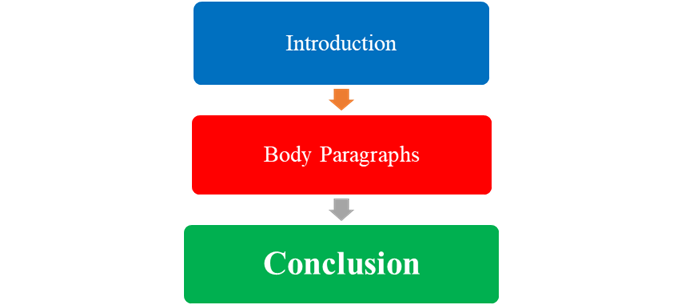
The
conclusion in argumentative essays has two
components.
1. The first part is a restatement of your argument.
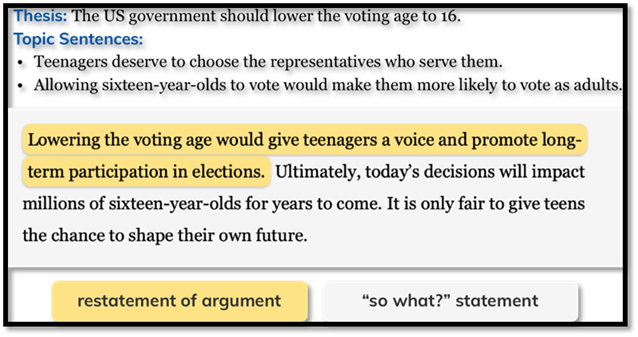
The restatement should
summarize your thesis and topic sentences to remind readers of the main points
of your essay.
Don't just
repeat the same words from your thesis and topic sentences! Express your main
points in a new language to make your conclusion more interesting for
your readers. Summarize the main points of your essay in new words to keep your
readers engaged.
Below are
some phrases you can use to tie together the ideas from your essay:
- In
short,
- In
the end,
- In
conclusion,
- To
sum up,
2. End your essay with a "so what" statement.
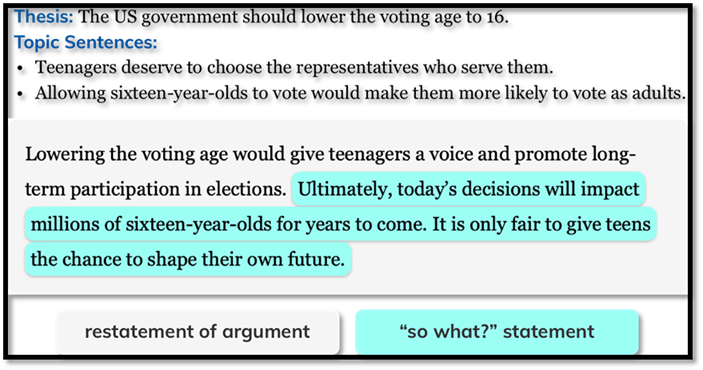
Your "so
what?" statement should drive your argument home by
showing readers why your thesis matters.
Model of an
Argumentative Essay
Read the
argumentative essay linked below, making sure to notice the parts and
components.
Parts of Speech: Review
Study the Google
slides to review the parts of speech.